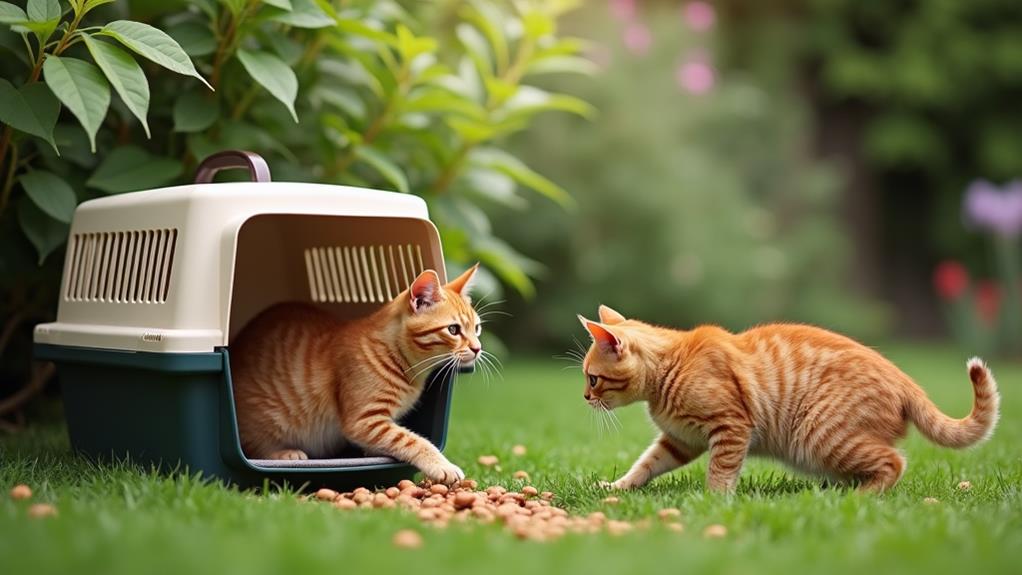How to Get a Feral Cat Into a Carrier: Stress-Free Techniques

To stress-free get a feral cat into a carrier, start by understanding their cautious behavior. Position the carrier in a quiet, familiar spot ahead of time and line it with a comforting blanket. Remove any stress hormones by cleaning the carrier with a biological solution and use pheromone spray to create a calming environment. Use strong-smelling food like tuna to lure them inside, and gradually place treats around to build positive associations. Handle the cat gently, using gloves and a towel if needed, and keep movements slow and calm. Uncover more ways to make this process smoother for both you and the cat.
Understanding Feral Cat Behavior
Understanding feral cat behavior is fundamental when you're trying to get one into a carrier. Feral cats, being unsocialized, naturally avoid human contact, which makes handling them a bit tricky. These cats are often wary of confined spaces like carriers, mainly due to negative experiences or an instinctive perception of danger. Their strong territorial instinct means they feel more secure in familiar environments. So, when you approach a feral cat, it's vital to do so with patience.
To minimize stress and anxiety, you should gradually desensitize the cat to the carrier. This involves introducing the carrier slowly and allowing the cat to investigate it at their own pace. Positive reinforcement, like offering food near the carrier, can help create a more inviting scenario. Remember, feral cats might hiss or growl as a defensive behavior, showcasing their fear rather than aggression.
Your goal is to shift the focus from fear to curiosity. By maintaining a calm demeanor and using patience and positive reinforcement, you can help alleviate the cat's anxiety. Eventually, this approach increases your chances of getting the feral cat into the carrier without causing further distress.
Preparing the Carrier
A well-prepared carrier is your key to reducing a feral cat's stress during transport. To begin, make certain the carrier is spacious enough for your cat to sit, stand, and turn around comfortably. This helps alleviate anxiety and creates a more pleasant experience for both you and the cat. Here are some steps to verify your carrier is ready:
- Line the Carrier: Use a familiar blanket or towel that carries your cat's scent. This familiar smell will create a calming environment and reduce anxiety.
- Clean Thoroughly: Use a biological solution to clean the carrier and remove any stress hormones from previous uses. A clean, fresh-smelling carrier is more inviting for the cat.
- Use Pheromone Spray: Apply a pheromone spray like Feliway inside the carrier. This helps create a calming atmosphere and encourages the cat to feel secure.
- Position Strategically: Place the carrier in a quiet room or familiar area a few days before travel. Allow the cat to investigate the carrier at their own pace, which helps them become comfortable with it.
Luring Techniques

Once your carrier is ready, it's time to focus on persuading the feral cat to enter it willingly. Start by placing the cat carriers in a familiar area where the cat feels comfortable. Leave the door open, allowing them to investigate without feeling trapped. This can make the process smoother by reducing anxiety. Try using strong-smelling food like tuna or sardines as bait inside the carrier. The enticing aroma will attract them, as feral cats are often motivated by hunger.
Gradually introduce treats around the carrier, encouraging the cat to associate it with positive experiences. This helps them get used to their new environment. Consistently put your cat's food inside the carrier at the same time each day, establishing a reliable feeding routine. This helps them connect the carrier with a dependable food source, making traveling with cats less stressful.
Engage the cat with toys or laser pointers, leading them closer to the carrier while they play. This can help reduce any feeling of being threatened. If needed, cover the carrier partially to create a more secure atmosphere. With patience, these techniques can guide the cat into the carrier calmly.
Safe Handling Strategies
In relation to safely handling a feral cat, you should, at the very least, start by wearing gloves and using a towel to gently wrap the cat. This provides a sense of security and reduces the risk of bites or scratches. Maintaining a calm demeanor is vital. Approach the cat quietly and avoid sudden movements, as these can increase the cat's anxiety and stress levels. Using a proper carrier is also important. Here's a quick guide to guarantee a smooth process:
- Choose the Right Carrier: Opt for a sturdy, well-ventilated carrier that's spacious enough for the cat to sit and turn comfortably. This minimizes feelings of confinement.
- Create a Secure Environment: After placing the cat inside, cover the carrier with a blanket to create a dark, secure space. This helps calm the cat during transport.
- Monitor Behavior: Keep an eye on the cat's behavior while handling. Look for signs of fear or distress and adapt your approach to maintain calmness.
- Stay Calm and Gentle: Consistently manage your own stress. Your calm presence can greatly impact the cat's comfort throughout the process.
Post-Capture Care

After successfully getting a feral cat into a carrier, your focus should shift to their post-capture care to guarantee a smooth recovery. Initially, take the cat to a vet for a thorough assessment. This step is vital to check for any injuries or illnesses and to schedule necessary vaccinations and spaying/neutering procedures. Once done, monitor the cat closely for signs of complications like excessive bleeding or unusual behavior during recovery.
Create a comfortable, quiet space for the cat to minimize stress. Familiar blankets or toys from their previous environment can help make this shift smoother. Confirm the cat has access to fresh water and high-quality food that meets their dietary needs. Proper hydration and nourishment are fundamental for their recovery.
As the feral cat begins to heal, gradually introduce them to their new environment. Allow them to investigate at their own pace to reduce anxiety. This approach helps them feel more comfortable and secure in their new surroundings. Remember, patience is key during this process. By attending to these details, you'll support the feral cat's path from capture to a healthier, more stable life.




